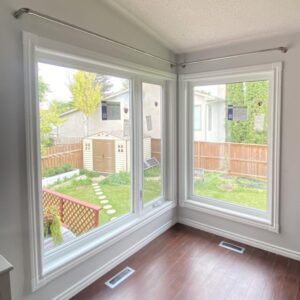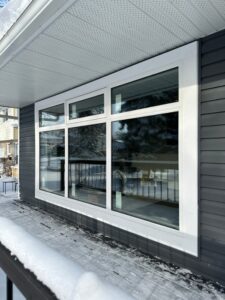New windows may be a significant investment, but if your windows are old or damaged, it something you will have to do eventually. Replacing old, drafty windows with more energy-efficient ones can help you save money over the long term. Inefficient, drafty windows can account for up to 35% of your home’s total heating and cooling loss, according to ENERGY STAR.
When it comes to energy-saving windows, double and triple-pane windows are at the top of the list. f you’re unsure about which one is best for your home or the differences and cost between the two, this guide will help you make an informed decision.
Table of Contents
ToggleWhy not single pane?
Single pane windows were once the standard for homes, but that has long since changed. Double pane windows are now the new standard, with triple pane windows offering even more energy efficiency. Still, older or historic homes may be outfitted with single-pane windows. The downside of these is there is no argon gas or added panes of glass to improve thermal performance and dampen sound from the outside. Your home will lose more energy as a result, and single-pane windows will allow outside sounds to travel more easily into the house. If you want to invest in energy efficiency, replacing your old single-pane windows should be the first place you start.
That said, single-pane windows still have their uses, especially as a less expensive option than double or triple-pane windows. Sheds or other outdoor buildings, for example, don’t always need higher efficient windows, making single pane windows an okay choice. Another great use for single plane glass is for decorative reasons, such as interior glass doors or glass partitions. It’ll work just as well for a stylish addition, and there is no need to pay extra for thermal performance in these applications.
Factors to keep in mind when purchasing new windows
When replacing or upgrading old windows in your home you want to choose quality, longevity, and efficiency. There are a few things to look for when considering cost and efficiency. Sticker labels on windows, for example, have useful information about the window’s overall efficiency. By understanding how to read them, you’ll be able to make a more informed purchase.
Energy efficiency, noise reduction, preventing costly air leaks, and improve your home’s aesthetic appeal will all play a role in your decision-making process. Lower-grade windows, while less expensive, won’t last or work as well over the long run. When it comes to windows, it’s always better to invest in quality from the start, in order to see a more significant return in the future. To ensure such quality, look for windows that offer these factors:
Energy efficiency
Energy-efficient windows will save money on overall heating and cooling costs. They are designed to trap heat or cold air so that your HVAC doesn’t work harder than necessary. ENERGY STAR certified windows are guaranteed to be highly efficient. These windows have low solar heat gain coefficient (SHGC), low air leakage, and low-E glass coatings. Altogether, it guarantees an overall higher efficient window and better longterm savings as a result.
SHGC: This refers to how much solar radiation can pass through a window and then get released as heat inside. Depending on where you live, the preferred rating will change. Colder climates will benefit from a higher rating to collect more solar heating in winter. Warmer areas need a lower rating to prevent too much heat from passing into the home during the summer.
Low air leakage: Air leaks are prevented by increased pressure across the surface and frame of a window. Low air leak ratings mean they are tighter and less likely to leak than higher ratings with less pressure.
Low-E coating: Low-E is an invisible coating added to windows to improve overall temperature control. In the winter, it maximizes how much heat is allowed through while minimizing heat loss. In the summer, it filters harmful UV light and reduces how much solar heat enters the home.
U-factor
This refers to how well a window can insulate the home. The U-factor is a measurement of the rate of heat transfer. The lower the number the better the insulation. R-value is another measurement of insulation, but it refers to heat resistance. With that, the higher the number, the better the resistance. When looking at the U-factor, make sure it relates to the window as a whole and not just the glass. That way, you can guarantee the entire window, including the frame and material, has a high-efficiency rating.
Materials
The right materials used for the frame will also play a role in the window’s overall quality. Investing in quality materials is just as beneficial in the long run as investing in a quality double or triple pane window. There are five different materials available for window frames:
Vinyl: PVC frames are excellent insulators and they have flexible customization options. Vinyl is also an affordable material making it popular among homeowners. The durability and low maintenance of vinyl frames also help with additional long-term savings.
Fibreglass: Despite being a little more expensive, fibreglass is a top contender for window frames. Fibreglass can easily expand and contract, so weather and temperature changes won’t cause it to crack or warp. It is also an excellent insulator, meaning it offers significant energy savings when professionally installed. Fibreglass is incredibly durable as well, making it a perfect support for heavier, triple pane windows.
Wood: One of the most traditional and aesthetically attractive options for window frames is wood. As a natural insulator, wood frames are excellent at trapping heat in the winter and cold air in the summer. That said, wood does need the most maintenance to ensure a long lifespan without costly repairs. Otherwise, rot, insects, and warping can cause severe damage to the frame.
Aluminum: This material is just as low maintenance as vinyl, but more resilient against rot and mould. Aluminum can be a more expensive option, however, it isn’t as energy efficient as other materials because aluminum is a conductor. Aluminum is a great noise insulator, so is a popular choice for buildings on busy streets. If you choose aluminum, ask about a thermal break enhancer to increase efficiency.
Style
The right style of window is not only important for overall appearances, but also overall efficiency. Windows come in a wide range of different designs, each with their own benefits and customizations to consider. However, three of the most efficient and popular styles are casement, double-hung, and sliding.
Casement: Casement windows open by swinging on a hinge attached to one side of the frame. The design welcomes plenty of ventilation but also helps to increase the efficiency rating. When closed, the sash seals tightly against the frame, minimizing any air leaks.
Double-hung: These windows can open either by lifting the bottom sash or the top to welcome in air. The versatile design optimizes efficiency as cold or hot air can be brought in from either the bottom or top sash, respectively. The window operates on a sliding track that, when sealed, will prevent leaks.
Sliding: Thanks to the airtight seal when a sliding window is closed, these are another highly efficient design. The wide window welcomes air and sunlight in, but seals to keep out drafts or heat loss. Sliding windows are a secure option, as they can be protected with a specialized lock.
Double pane windows
As the name suggests, double pane windows have two sheets of glass with a small space between the two panes. This space is filled with argon gas, which drastically improves the overall insulation ratings of the window. Compared to single pane, double pane windows are easily twice as beneficial and efficient.

Benefits
The long-term saving is a significant benefit when choosing double pane windows. Replacing all single pane with double pane windows can save 35% on heating and cooling bills. The added argon gas between the panes helps insulate and dampen outside noises, keeping your home quieter year-round. Double-pane windows have a U-factor of 0.30 and an R-value between 3.5-4.
Added features such as low-E coatings will help reflect energy, keeping the heat in during the winter and heat out in the summer. It can also help with the condensation build-up and extend the lifespan of your windows. Pairing a double pane window with a casement or siding design or vinyl frame will add even more efficiency.
Considerations and cost
To fully maximize the benefits of double pane windows, all old or single-pane windows must be replaced. Otherwise, the pre-existing windows will continue to leak air and heat from home. As a result, the potential benefits from a few new windows will be lost. Also, investing in a professional to install the windows is a must. Without proper installation, windows can fail prematurely, or poor installation can cause unwanted and costly air leaks.
With that in mind, the cost of double pane windows is something else to consider. Compared to single-pane windows, they will be more expensive, but the ROI is much better. Lower end double-pane windows will cost approximately $385 per window, while the average costs range from $550 to upwards of $850. Professional labour will be an added $40 per window to install. Keep in mind that frame materials, such as wood vs vinyl, will also affect the final price. The best way to get an accurate range is to call in a contractor to inspect your home and give an estimate.
Triple pane windows
Triple pane or triple glazed windows offer all the same benefits of double, but with even better efficiency. The simple reason is that with three panes of glass, with insulating argon gas between each layer, there are more layers to protect against heat loss and outside temperatures. Like double pane windows, choosing vinyl frames or a double-hung design can further increase the overall benefits.

Benefits
The third panel of glass creates extra space for a second layer of both argon gas and a low-E coating to further the overall window performance. Triple pane windows, for example, have a U-factor as low as 0.15 and an R-value as high as 9-10. In comparison, double-pane windows have a U-factor of 0.30 and an R-value between 3.5-4. In terms of cost savings, that translates to 2-3% saved annually on heating bills. Sound-wise as well, triple pane windows are superior, making them ideal for city homes or noisy areas.
Considerations
There are some considerations to keep in mind before installing triple-pane windows. Because of their design, they are much heavier, so your home must be able to support the weight. They also will need a more durable frame which can further increase the overall cost.
In general, expect to pay between 10-15% more for triple-pane windows than double pane. On average, the price ranges from $818 to upwards of $1,085. Low-end costs are around $550, but with triple-pane, quality is always a better investment. The labour and installation costs will also range around $40 per window.
Which is right for you?
Both double and triple panes are excellent choices for any home, so the decision comes down to cost and location. Triple pane cost more, but also offer higher thermal performance. If you plan to stay in your home for many more years, then it’s a great choice. The cost will pay for itself during that time, and you get to enjoy the benefits for years. When selling, double pane windows are the better choice for cost vs value. Potential buyers will value new, upgraded windows, and the efficiency savings provided by the windows. Double pane windows will also add resale value, which you can put towards a new home.
As for location, there are few considerations. Triple pane is better suited to noisy areas as they are superior in noise dampening. Suppose you live in a colder region of Canada as well. In that case, the triple-pane is better suited to minimizing any heat loss throughout the winter months. The opposite is true for double pane windows, where quieter areas and warmer climates are the better fit. If you’re not sure, just call in a professional for help. They’ll help find the best match for your house’s needs and your budget and lifestyle.
Leave the installation to the pros
While it may be tempting to cut down costs by DIYing new windows, its best left to the pros. DIYing window installation without experience invites unnecessary risks such as dropping or breaking the windows, or personal injuries from mishandling ladders. It also risks lowering the value of your home, instead of increasing it. While professionals have insurance and certification that ensures value, a DIYer likely won’t. Potential buyers will be more interested in a home whose value and safety are ensured by a professional’s work, than by a nonprofessional. Hiring a contractor will also save time, stress, and in the long-term, money.










